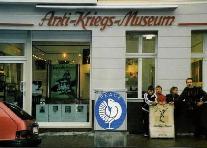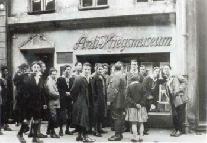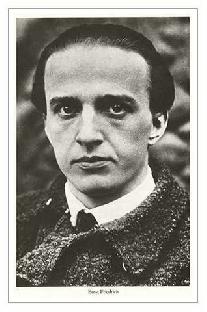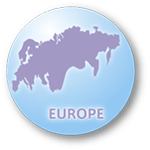EUROPE
Ernst Friedrich's Anti-War Museum (Germany)
(Nov. 4, 2009)
by Tommy Spree, Director
The Anti-War Museum is a place where documents about war events and peace work are collected, evaluated and exhibited. Members of the Anti-War Museum spread pacifism through peace education, such as work with youth groups and school classes, readings, and film screenings. The museum works closely together with other pacifist groups.
The pacifist and anti-fascist Ernst Friedrich founded the first Anti-War Museum in the year 1925. Ernst Friedrich brought together war material and photos from World War I and exhibited them to show the horrors of war. The Anti-War Museum was located in Parochialstr. 29 in the centre of Berlin from 1925 until the destruction by the SA (Nazi storm troopers) in March 1933. The Nazis changed the Anti-War Museum into an SA site, where they tortured opponents of the Nazi regime. Ernst Friedrich's activities led to 13 convictions between 1923 and 1933. In 1924 the first volume of his book "War against War" was published. It was distributed by the International Federation of Trade Unions and became widely known.
Ernst Friedrich was able to save the most important exhibits and printings from destruction. He and his family flew over Prague and Switzerland to Belgium in 1933 and he opened the second Anti-War Museum in Brussels in 1936. However, it was destroyed again, this time by German troops when they invaded Belgium in 1940. In 1950 Ernst Friedrich made a request of Berlin Mayor Emst Reuter to leave the ruins of the Kaiser Wilhelm Gedaechtniskirche--a famous church--to him in order to establish another Anti-War Museum. This request was not fulfilled and Ernst Friedrich eventually died on May 2, 1967.
Fifteen years after his death, the ideas of this important anti-militarist were revived. Part of the German peace moveツャment saw Ernst Friedrich as one of their most determined and dedicated representatives. The third Anti-War Museum was established by a group of teachers headed by Tommy Spree, a grandson of Ernst Friedrich, in 1982. The founding of a new Anti-War Museum was at last fulfilled. The existence and work of this museum is surely an important contribution to the realization of a vision of the future as expressed by Robert Jungk: "I hope that this city of national arrogance that has suffered so much in World War II will become a huge workshop for peace."
The latest Anti-War Museum displays mainly historical material in the form of photos, objects and documents from World War I and World War II in the largest room. Some original pieces from Emst Friedrich's first museum from the Great War can be seen, like a poster of a huge explosive shell and a butter former in the shape of an Iron Cross. Friedrich was a man with a strong vision of peace, an idealist and yet a pragmatist. He was a person who knew what war means, and who was mad enough to believe that one could stop mankind from the madness of waging war against one another. Other pieces from World War I and World War II have been donated or lent to the museum by Berliners. In another room exhibits about atom bombs, chemical warfare and mine fields are shown. Artists can show their work about war and peace in the Peace Gallery which belongs to the Anti-War Museum. In the cellar there is an original air-raid shelter fully equipped with historical objects.
The pacifist volunteer workers of the Anti-War Museum seek to help create a world without hatred and weapons and hope to bring out a new way of understanding, peace building and love of nature.
Address: Bruesseler Str. 21 - 13353 Berlin (Germany)
Phone: -49+30 -45490110
Homepage: www.anti-kriegs-museum.de
Open: 4:00~8:00 p.m. daily (also on Sundays), except Christmas and New Year
Admission: Free
(Originally published on Oct. 19, 2009)
 The Anti-War Museum in Berlin. The exhibits include artifacts donated by citizens. |  The first Anti-War Musuem opened in 1925. |  Ernst Friedrich |
 Peace Museums of EUROPE
Peace Museums of EUROPE